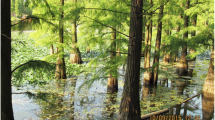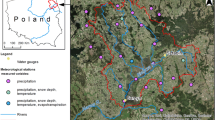Abstract
Limnology and wetland ecology are intimately related, because in both, water is an essential factor. Despite this, wetlands are water-dependent ecosystems that are neither terrestrial nor aquatic. Unlike aquatic ecosystems, they have soils but they also have standing water, so they are not truly terrestrial. For this reason, some limnologists have historically considered that wetlands were an object of study for terrestrial ecologists and vice versa. The International Convention on Wetlands itself adopted an enumerative definition of wetlands that includes purely aquatic ecosystems, thus leading to further confusion around the wetland concept. Key environmental factors controlling wetlands include geomorphic setting, soil properties, fire frequency, hydroperiod and water sources. In this context, Brinson’s functional wetland classification based on hydrogeomorphic aspects was used in the regionalisation of Argentinean wetlands, which included a Patagonian region with three continental wetland subregions: (1) Lakes, watercourses and mallines of the Patagonian Andes. (2) Lagunas and vegas of the extra-Andean Patagonia. and (3) Mallines and turberas of Austral Patagonia and South Atlantic Islands. Wetlands of the Chilean Patagonia are similar to those of the Argentinean sector, though some peculiar wetland types such as ñadis and cátricos are also found. Wetlands have been and continue to be part of many human cultures in the world. These ecosystems are among the most important in the world since they provide approximately 40% of all ecosystems’ contributions to people. Although these nature contributions to people are particularly important in Patagonia (e.g. freshwater sources, forage for livestock, carbon sinks and habitat for biodiversity), continental wetlands as well as aquatic ecosystems in this region are facing many threats due to changes in land use associated with global change. Therefore, we urge the necessity of public politics focused on their conservation and sustainable use.
Access this chapter
Tax calculation will be finalised at checkout
Purchases are for personal use only
Similar content being viewed by others
Notes
- 1.
For the purpose of this Convention, wetlands are areas of marsh, fen, peatland or water, whether natural or artificial, permanent or temporary, with water that is static or flowing, fresh, brackish or salt, including areas of marine water the depth of which at low tide does not exceed 6 metres. May incorporate riparian and coastal zones adjacent to the wetlands, and islands or bodies of marine water deeper than 6 metres at low tide lying within the wetlands.
References
Aquino DS, Gavier-Pizarro G, Quintana RD (2021) Disentangling the effects of hydro-climatic factors and land use intensification on wetland vegetation dynamics in the Lower Delta of the Paraná River. Remote Sens Appl Soc Environ 21:100466. https://doi.org/10.1016/j.rsase.2021.100466
Benzaquén L, Blanco D, Bó R et al (2017) Regiones de humedales de la Argentina. Ministerio de Ambiente y Desarrollo Sustentable, Fundación Humedales/Wetlands International, Universidad Nacional de San Martín y Universidad de Buenos Aires, Buenos Aires
Blanco DE, De La Balze VM (2004) Los turbales de la Patagonia: Bases para su inventario y la conservación de su biodiversidad. Wetlands International, Publicación 19, Buenos Aires
Bran D (2004) Los mallines de la Patagonia extrandina. In: Malvárez AI, Bó RF (eds) Documentos del curso taller Bases ecológicas para la clasificación e inventario de humedales en Argentina. FCEyN-UBA-Ramsar-USFWS-USDS, Buenos Aires, pp 59–70
Brinson MM (1993) Changes in the functioning of wetlands along environmental gradients. Wetlands 13:65–74
Brinson MM (2004a) Niveles extremos de variación de patrones y procesos en humedales. In: Malvárez AI, Bó RF (eds) Documentos del curso taller Bases ecológicas para la clasificación e inventario de humedales en Argentina. FCEyN-UBA-Ramsar-USFWS-USDS, Buenos Aires, pp 19–24
Brinson MM (2004b) Conceptos y desafíos de la clasificación de humedales. In: Malvárez AI, Bó RF (eds) Documentos del curso taller Bases ecológicas para la clasificación e inventario de humedales en Argentina. FCEyN-UBA-Ramsar-USFWS-USDS, Buenos Aires, pp 25–36
Buria L (2017) Subregión Lagos, cursos de agua y mallines de los Andes patagónicos. In: Benzaquén L, Blanco D, Bó R, Kandus P, Lingua G, Minotti P, Quintana RD (eds) Regiones de humedales de la Argentina. Ministerio de Ambiente y Desarrollo Sostenible, Fundación Humedales/Wetlands International, Universidad Nacional de San Martín y Universidad de Buenos Aires, Buenos Aires, pp 269–282
Chan EKF, Timmermann A, Baldi BF et al (2019) Human origins in a southern African palaeo-wetland and first migrations. Nature 575:185–189. https://doi.org/10.1038/s41586-019-1714-1
Coles B, Coles J (1989) People of the wetlands: bogs, bodies and lake-dwellers. Thames & Hudson, London
Collantes M, Faggi AM (1999) Los humedales del sur de Sudamérica. In: Malvárez AI (ed) Tópicos sobre humedales subtropicales y templados de Sudamérica. MAB-ORCYT, Montevideo, pp 15–25
Convention on Wetlands (2018) Global wetland outlook: state of the world’s wetlands and their services to people. Secretariat of the Ramsar Convention, Gland
Convention on Wetlands (2021) Global wetland outlook: special edition 2021. Secretariat of the Convention on Wetlands, Gland
Costanza R, d’Arge R, de Groot R et al (1997) The value of the world’s ecosystem services and natural capital. Nature 387:253–259
Cowardin LM, Carter V, Golet FC, LaRoe ET (1979) Classification of wetlands and deepwater habitats of the US. Diane Publishing, USA
Filipová L, Hédl R, Dančák M (2013) Magellanic wetlands: more than moor. Folia Geobot 48:163–188. https://doi.org/10.1007/s12224-012-9143-z
Hauenstein E, González M, Peña-Cortés F, Muñoz-Pedreros A (2005) Diversidad vegetal en humedales costeros de la región de la Araucanía. In: Smith-Ramírez C, Armesto JJ, Valdovinos C (eds) Historia, Biodiversidad y Ecología de los Bosques Costeros de Chile. Editorial Universitaria, Santiago, pp 197–205
Hudson AM, Olsen JW, Quade J et al (2016) A regional record of expanded Holocene wetlands and prehistoric human occupation from paleowetland deposits of the western Yarlung Tsangpo valley, southern Tibetan Plateau. Quatern Res:13–33. https://doi.org/10.1016/j.yqres.2016.04.001
IPBES (2019) Summary for policymakers of the global assessment report on biodiversity and ecosystem services of the Intergovernmental Science-Policy Platform on Biodiversity and Ecosystem Services. IPBES Secretariat, Bonn
Janauer GA (2000) Ecohydrology: fusing concepts and scales. Ecol Eng 16:9–16. https://doi.org/10.1016/S0925-8574(00)00072-0
Kandus P, Minotti P (2018) Propuesta de un marco conceptual y lineamientos metodológicos para el Inventario Nacional de Humedales. Informe Final, Ministerio de Ambiente y Desarrollo Sostenible de la Nación (Argentina) – 3iA UNSAM, Buenos Aires
Kandus P, Quintana RD, Minotti PG et al (2011) Ecosistemas de humedal y una perspectiva hidrogeomórfica como marco para la valoración ecológica de sus bienes y servicios. In: Laterra P, Jobbagy E, Paruelo J (eds) Valoración de servicios ecosistémicos: conceptos, herramientas y aplicaciones para el ordenamiento territorial. Instituto Nacional de Tecnología Agropecuaria (INTA), Buenos Aires, pp 265–290
Keddy PA (2016) Wetland ecology. Principles and conservation. Cambridge University Press, Cambridge, UK, 2nd
Latorre C, Santoro CM, Ugalde PC et al (2013) Late Pleistocene human occupation of the hyperarid core in the Atacama Desert, northern Chile. Quat Sci Rev 77:19–30. https://doi.org/10.1016/j.quascirev.2013.06.008
Margalef R (1983) Limnología. Ediciones Omega, Barcelona
Martínez Carretero E (2004) Los turbales patagónicos. In: Blanco D, de la Balze MV (eds) Los Turbales de la Patagonia: Bases para su inventario y la conservación de subiodiversidad. Publicación Nº 19. Wetlands Internacional, Buenos Aires, Argentina, pp 45–48
Mataloni G (2017) Subregión Mallines y turberas de la Patagonia Sur e islas del Atlántico Sur. In: Benzaquén L, Blanco D, Bó R, Kandus P, Lingua G, Minotti P, Quintana RD (eds) Regiones de humedales de la Argentina. Ministerio de Ambiente y Desarrollo Sostenible, Fundación Humedales/Wetlands International, Universidad Nacional de San Martín y Universidad de Buenos Aires, Buenos Aires, pp 299–309
Mazzoni E (2017) Subregión Lagunas y vegas de la Patagonia extrandina. In: Benzaquén L, Blanco D, Bó R, Kandus P, Lingua G, Minotti P, Quintana RD (eds) Regiones de humedales de la Argentina. Ministerio de Ambiente y Desarrollo Sostenible, Fundación Humedales/Wetlands International, Universidad Nacional de San Martín y Universidad de Buenos Aires, Buenos Aires, pp 283–298
McInnes RJ, Davidson NC, Rostron C, Simpson M (2020) A citizen-science state of the world’s wetlands survey. Wetlands 40:1577–1593. https://doi.org/10.1007/s13157-020-01267-8
Mitsch WJ, Gosselink JG (2015) Wetlands, 5th edn. Wiley, New Jersey
Promis A (2010) Humedales anegadizos de la Patagonia Chilena. Proyecto FPA (CONAMA) “Conservación de mallines. Una alternativa para proteger humedales, educación ambiental y desarrollo de actividades ecoturísticas” and Programa de Bosques Patagónicos. Depto. de Silvicultura y Conservación de la Naturaleza, Universidad de Chile, Santiago
Raffaele E (1999) Mallines: aspectos generales y problemas particulares. In: Malvárez AI (ed) Tópicos sobre humedales subtropicales y templados de Sudamérica. MAB-ORCYT, Montevideo, pp 27–33
Ramírez C, San Martín C (2008) Ecosistemas dulceacuícolas. In: CONAMA. Biodiversidad de Chile, Patrimonio y Desafíos. Ocho Libros Editores, Santiago de Chile, pp 106–116
Ramírez C, Ferriere F, Figueroa H (1983) Estudios fitosociológicos de bosques pantanosos templados del sur de Chile. Rev Chil Hist Nat 56:11–26
Ramírez C, San Martin C, Uribe F, MacDonald R (1993) La vegetación nativa de los suelos ñadi valdivianos. Agric Técnica (Chile) 53:55–74
Roig FA (1998) La vegetación de la Patagonia. In: Correa M (ed) Flora patagónica. Instituto Nacional de Tecnología Agropecuaria (INTA), Colección Científica 13, Buenos Aires, pp 48–166
Rovere AE, Premoli AC, Newton AC (2002) Estado de conservación del ciprés de las guaitecas (Pilgerodendron uviferum) en Argentina. Bosque (Chile) 23:11–19. https://doi.org/10.4206/bosque.2002.v23n1-02
Schlatter RP, Schlatter JE (2004) Los turbales de Chile. In: Blanco DE, de la Balze VM (eds) Los Turbales de la Patagonia: Bases para su inventario y la conservación de su biodiversidad. Publicación N° 19. Wetlands International, Buenos Aires, pp 75–79
Shaw SP, Fredine CG (1956) Wetlands of the United States: their extent and their value to waterfowl and other wildlife. US Department of the Interior, Fish and Wildlife Service, Washington, DC
Sica YV, Quintana RD, Radeloff VC, Gavier-Pizarro GI (2016) Wetland loss due to land use change in the Lower Paraná River Delta, Argentina. Sci Total Environ 568:967–978. https://doi.org/10.1016/j.scitotenv.2016.04.200
Sica Y, Gavier-Pizarro G, Pidgeon A, Travaini A, Bustamante J, Radeloff V, Quintana RD (2018) Changes in bird assemblages in a wetland ecosystem after 14 years of intensified cattle activity. Austral Ecol 43:786–797. https://doi.org/10.1111/aec.12621
Smith RD, Ammann A, Bartoldus C, Brinson MM (1995) An approach for assessing wetland functions using hydrogeomorphic classification, reference wetlands and functional indices. Technical Report, TR-WRP-DE-9. Waterways Experiment Station, Army Corps of Engineers, Vicksburg
Vaughan IP, Diamond M, Gurnell AM et al (2007) Integrating ecology with hydromorphology: a priority for river science and management. Aquat Conserv Mar Freshwat Ecosyst 19(1):113–125. https://doi.org/10.1002/aqc.895
Zedler JB (2003) Wetlands at your service: reducing impacts of agriculture at the watershed scale. Front Ecol Environ 1:65–72
Zonneveld IS, Barendregt A (2009) Human activities in European tidal freshwater wetlands. In: Barendregt A, Whigham D, Baldwins A (eds) Tidal freshwater wetland. Margraf Publishers, Weikersheim, pp 11–20
Author information
Authors and Affiliations
Corresponding author
Editor information
Editors and Affiliations
Rights and permissions
Copyright information
© 2022 The Author(s), under exclusive license to Springer Nature Switzerland AG
About this chapter
Cite this chapter
Quintana, R.D., Mataloni, G. (2022). Are Wetlands Freshwaters?. In: Mataloni, G., Quintana, R.D. (eds) Freshwaters and Wetlands of Patagonia. Natural and Social Sciences of Patagonia. Springer, Cham. https://doi.org/10.1007/978-3-031-10027-7_2
Download citation
DOI: https://doi.org/10.1007/978-3-031-10027-7_2
Published:
Publisher Name: Springer, Cham
Print ISBN: 978-3-031-10026-0
Online ISBN: 978-3-031-10027-7
eBook Packages: Biomedical and Life SciencesBiomedical and Life Sciences (R0)




